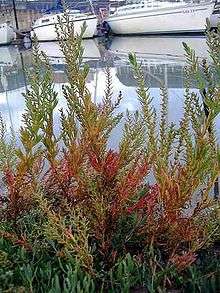Suaeda
Suaeda is a genus of plants also known as seepweeds[1] and sea-blites. Most species are confined to saline or alkaline soil habitats, such as coastal salt-flats and tidal wetlands. Many species have thick, succulent leaves, a characteristic seen in various plant genera that thrive in salty habitats (halophile plants).
| Suaeda | |
|---|---|
 | |
| Suaeda maritima | |
| Scientific classification | |
| Kingdom: | Plantae |
| Clade: | Tracheophytes |
| Clade: | Angiosperms |
| Clade: | Eudicots |
| Order: | Caryophyllales |
| Family: | Amaranthaceae |
| Subfamily: | Suaedoideae |
| Genus: | Suaeda Forssk. ex J.F. Gmel. |
| Species | |
|
About 110 | |
There are about 110 species in the genus Suaeda.[2]
The most common species in northwestern Europe is Suaeda maritima. It grows along the coasts, especially in saltmarsh areas, and is known in English as common seablite. It is also common along the east coast of North America from Virginia northward. One of its varieties is common in tropical Asia on the land-side edge of mangrove tidal swamps. Another variety of this polymorphic species is common in tidal zones all around Australia (Suaeda maritima var. australis is also classed as Suaeda australis). On the coasts of the Mediterranean Sea a common Suaeda species is Suaeda vera (synon. S. fruticosa). This is known as "shrubby sea-blite" in English, in distinguishment from common sea-blite. It grows taller and forms a bush.
The name Suaeda comes from an oral (non-literary) Arabic name suaed | sawād | suēd [3] for the Suaeda vera species and it was assigned as the genus name by the 18th century taxonomist Peter Forsskal during his visit to the Red Sea area in the early 1760s.[2][4][5]
The genus includes plants using either C3 or C4 carbon fixation. The latter pathway evolved independently three times in the genus and is now used by around 40 species. Suaeda aralocaspica, classified in its own section Borszczowia, uses a particular type of C4 photosynthesis without the typical "Kranz" leaf anatomy.[6][7][8]
Uses
In the medieval and early post-medieval centuries it was harvested and burned, and the ashes were processed as a source for sodium carbonate for use in glass-making; see glasswort. In Mexico, some species such as Suaeda pulvinata are cooked in traditional dishes known as romeritos.
Selected species
- Suaeda aegyptiaca
- Suaeda aralocaspica - formerly known as Borszczowia aralocaspica, a central Asian halophyte
- Suaeda asphaltica - Asphaltic seablite
- Suaeda australis - Austral seablite
- Suaeda calceoliformis - Pursh seepweed, broom seepweed, horned seablite
- Suaeda californica - California seablite
- Suaeda conferta - beach seepweed
- Suaeda corniculata - jiao guo jian peng
- Suaeda depressa - alkaki seepweed
- Suaeda esteroa - estuary seablite
- Suaeda glauca - jian peng
- Suaeda japonica[9]
- Suaeda linearis - annual seepweed, narrow-leaf seablite
- Suaeda maritima - herbaceous seepweed
- Suaeda mexicana - Mexican seepweed
- Suaeda monoica - spread from Egypt across the Arabian Peninsula to Pakistan
- Suaeda novae-zelandiae - New Zealand sea blite
- Suaeda nigra - bush seepweed, romerillo
- Suaeda occidentalis - western seepweed
- Suaeda palaestina
- Suaeda pulvinata
- Suaeda rolandii - Roland's seablite
- Suaeda salina
- Suaeda suffrutescens - desert seepweed
- Suaeda tampicensis - coastal seepweed
- Suaeda taxifolia - woolly seablite
- Suaeda torreyana - iodine weed
- Suaeda vera - alkali seepweed
- Suaeda vermiculata
References
- "Suaeda". Natural Resources Conservation Service PLANTS Database. USDA. Retrieved 4 December 2015.
- Entry for Suaeda in Flora of North America.
- Article Soda, by Arnald Steiger, year 1937, on pages 74-75
- Entry for Suaeda in the Jepson Manual Online.
- Peter Forskål's book Flora Aegyptiaco-Arabica, published 1775, in Latin, declares Suæda as a newly created genus name, with the name taken from an Arabic name Suæd – said on page XXXVIII – and presents the species members of the new genus on pages 69-71.
- Schütze, P.; Freitag, H.; Weising, K. (2003). "An integrated molecular and morphological study of the subfamily Suaedoideae Ulbr. (Chenopodiaceae)". Plant Systematics and Evolution. 239 (3–4): 257–286. doi:10.1007/s00606-003-0013-2. ISSN 0378-2697.
- Kapralov, M.V.; Akhani, H.; Voznesenskaya, E.V.; Edwards, G.; Franceschi, V.; Roalson, E.H. (2006). "Phylogenetic Relationships in the Salicornioideae / Suaedoideae / Salsoloideae s.l. (Chenopodiaceae) clade and a clarification of the phylogenetic position of Bienertia and Alexandra using multiple DNA sequence datasets". Systematic Botany. 31 (3): 571–585. doi:10.1600/036364406778388674. ISSN 0363-6445.
- Sage, R.F. (2016). "A portrait of the C4 photosynthetic family on the 50th anniversary of its discovery: species number, evolutionary lineages, and Hall of Fame". Journal of Experimental Botany. 67 (14): 4039–4056. doi:10.1093/jxb/erw156. ISSN 0022-0957. PMID 27053721.

- "Suaeda japonica". www.uniprot.org.
| Wikispecies has information related to Suaeda |
| Wikimedia Commons has media related to Suaeda. |